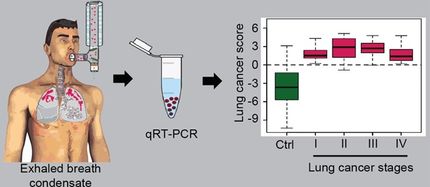Optical 'dog's nose' may hold key to breath analysis
University of Adelaide researchers are developing a laser system for fast, non-invasive, onsite breath analysis for disease, potentially enabling screening for a range of diseases including diabetes, infections and various cancers in the future.
The researchers have developed an instrument they equate to an "optical dog's nose" which uses a special laser to measure the molecular content of a sample of gas.
"Rather than sniffing out a variety of smells as a dog would, the laser system uses light to "sense" the range of molecules that are present in the sample," says Dr James Anstie, Australian Research Council (ARC) Research Fellow with the University's Institute for Photonics and Advanced Sensing (IPAS).
"Those molecules are by-products of metabolic processes in the body and their levels change when things go wrong. There have been good studies undertaken around the world which show that diseases like lung and oesophageal cancer, asthma and diabetes can be detected in this way, even before external symptoms are showing."
Breath analysis is a relatively new field being pursued around the world. But the system being developed offers almost-instant results, high sensitivity and the ability to test for a range of molecules at once -- making it promising for broadscale health screening.
Published in the journal Optics Express, Dr Anstie and colleagues including Masters student Nicolas Bourbeau Herbert, PhD student Sarah Scholten, senior research associate Dr Richard White and IPAS director Professor Andre Luiten detail their use of optical spectroscopy to detect the light-absorption patterns of different molecules, with high levels of accuracy and speed.
The system uses a specialised laser - an optical frequency comb - that sends up to a million different light frequencies through the sample in parallel. Each molecule absorbs light at different optical frequencies and therefore has a unique molecular fingerprint.
"We now have a robust system to be able to detect the presence and concentrations of molecules in a sample," says Dr Anstie. "The next step is to work out how to accurately sample and interpret the levels which will naturally vary from person to person."
Dr Anstie believes the group will have a working prototype in 2-3 years and a commercial "plug and play" product could be available in 3-5 years. Other potential applications include measuring trace gasses, such as atmospheric carbon dioxide, and detecting impurities in natural gas streams.
Other news from the department science

Get the analytics and lab tech industry in your inbox
By submitting this form you agree that LUMITOS AG will send you the newsletter(s) selected above by email. Your data will not be passed on to third parties. Your data will be stored and processed in accordance with our data protection regulations. LUMITOS may contact you by email for the purpose of advertising or market and opinion surveys. You can revoke your consent at any time without giving reasons to LUMITOS AG, Ernst-Augustin-Str. 2, 12489 Berlin, Germany or by e-mail at revoke@lumitos.com with effect for the future. In addition, each email contains a link to unsubscribe from the corresponding newsletter.


























































